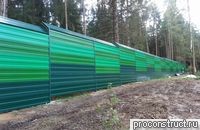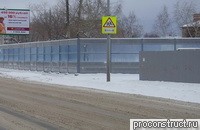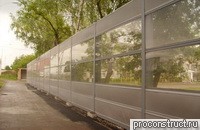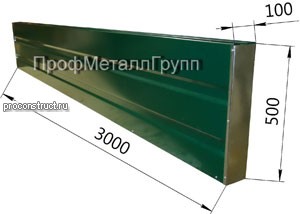Noise Reflecting Panels for Noise Barriers
Along with perforated noise attenuating panels, ProfMetalGroup produces two types of noise reflecting panels for sound insulation: transparent panels and blind metal panels.
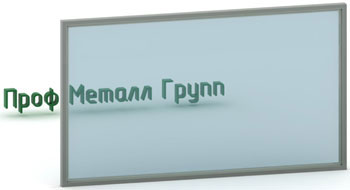
Transparent Noise Reflecting Panels
Transparent noise reflecting panels produced by ProfMetalGroup, consist of aluminium frame and transparent solid PMMA or polycarbonate 8 to 12 mm thick. It can be also made of cellular polycarbonate being is less translucent and having lower sound insulating factor for a cheaper price compared to solid materials. The choice of material depends on application or the customer's technical specification. Standard panel dimensions are 3x1 m and 2x1.5 m. This is the optimal balance of dimensions and cost for transparent panels 8 or 10 mm thick containing acrylic glass or polycarbonate sheets. Wider sheets require thicker layers of polycarbonate or acrylic glass resulting in a higher cost. Transparent panels can be installed into sound barriers both separately and jointly with metal non-transparent sound reflecting and sound attenuating panels.
When installed correctly and tightly, transparent sound insulating panels offer sufficient sound insulating features allowing to achieve significant sound load reduction and at the same time avoid the feeling of confinement, increase visibility and illumination in the area. Compared to metal panels, their disadvantages are lower sound insulating capacity and higher price.
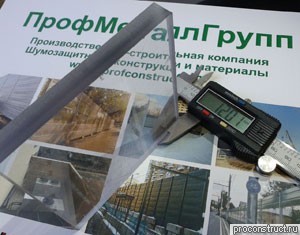
We also offer frameless translucent noise barriers, in which we use acrylic glass or polycarbonate sheets 12 to 20 mm thick. Thicker and respectively more durable acrylic glass allows for a bigger area of translucent surface to be set up. Our standard design for transparent acoustic barriers containing acrylic glass sheet is 12 mm thick, section dimensions are 1.5x2.5 m, 1.5x3 m and up to 6 meters high. It is possible to increase spaces between the sound barrier stands depending on polycarbonate thickness increase. Sound barriers with acrylic glass sheet 14, 16, 18, and 20 mm thick can be up to 3000x200 mm in size. The cost of transparent acoustic barriers with polycarbonate sheet 14 to 20 mm thick is significantly higher than that of thinner sound protection translucent panels.



Blind Metal Sound Reflecting Panels
Blind metal sound-reflecting panels have absolutely no perforation on the front sheet. Therefore, a sound wave gets reflected from such a panel with significantly higher efficiency. Blind sound reflecting panels cost significantly cheaper than perforated noise attenuating panels.
Besides the common advantages, like efficiency, maintainability, easy installation, etc., blind noise reflecting panels offer a whole range of exclusive benefits:
1. PShO 100.500 and PShO 075.500 panels comply with optimal sound insulating and sound attenuating features and stiffness parameters (bending stiffness) of enclosure, allowing sound insulation to demonstrate its top sound protection parameters based on inertial sound transmission. Panels of our manufacture, being multi-layered structures, consist of several layers flexibly connected to each other, and the vibration range of each layer may be different. Therefore, they offer higher sound insulating specifications compared to homogeneous structures.
A barrier made of glued sandwich panels with foamed plastic or high density mineral wool is an acoustically homogeneous and extremely rigid structure, which, receiving a sound wave, both reflects it and, when forced vibration frequency (incident sound wave) coincides with barrier vibration frequency (wave coincidence effect), also converts the sound momentum energy into mechanical vibration of the structure, creating a stream of secondary sound waves (spatial acoustic resonance). Therefore, it is not recommended to use glued wall-mounted sandwich panels of foamed plastic (which is absolutely not a sound attenuating material) or high density mineral wool for making a noise protection barrier. It is very important not to confuse acoustic noise protection panels with wall-mounted glued sandwich panels while choosing materials for noise protection barrier design or construction.
2. Our panels have an air layer between textured metal facing sheet and the low density basalt wool sheet, allowing to prevent direct transmission of vibration to the barrier sheet. As to the increased sound insulation effect, air space between acoustic panel elements offers nearly the same features as an air layer between the glass sheets in a window frame left in order to increase heat insulation.
3. We use special low density basalt wool with non-confined air-bubble voids as a noise attenuating material. (Highly porous materials with slightly opened pores, like polystyrene foam, have very low sound attenuating parameters.) Such a mineral wool plate consists of superfine basalt fibre bound in different directions and forming multiple interconnected air cavities. Sound attenuating specifications of a material depend on its density, fibre diameter, and the extent of pore openness, and the specific area of interior pore surface depends on fibre diameter and material density. Correctly adjusted balance between fibre diameter and its quantity, i.e. density, allows to produce a material with required sound insulation specifications.
By the results of recent research, in order to provide high quality sound insulation it is necessary to use fibrous materials with density not less than 40 kg/m3. It is mainly due to the increase of acoustic parameters of the fibrous insulation material based on its density increase. For example, the sound insulation rate within the low and middle frequency range of a fibrous material with density of up to 20 kg/m3 is less than that of a higher density material. However, further significant density increase entails the increase of material stiffness which, in its turn, impairs sound insulation features. Therefore, the optimal density of sound insulation material is 40 kg/m3.
4. In order to increase sound insulation efficiency in our production of sound protection panels, we use a range of design solutions with vibration damping materials and acoustic uncoupling, breaking rigid mechanical links between structure elements. Also, by using vibration insulating materials we increase the sound protection barrier tightness as tightness is one of the main sound insulation parameters.
Our offer of acoustic panels is among the most cost effective ones on the market. The term of order fulfilment depends on its scope. Please send your order to our e-mail or use the phone numbers given on the website to call us now.
